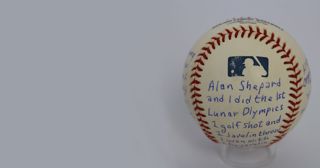
Apollo 14 and the Lunar Olympics
- 20th Feb 2019
- Author: Dan Kendall
Summer Olympics or Winter Olympics? Which is best? True space fans know that the best Olympics actually happen on the Moon. And for that, we can thank the crew of Apollo 14.
The Apollo 14 astronauts managed to place the Moon alongside the great sporting venues of Wembley, Anfield, Flushing Meadows, and … ok, ok, so perhaps I’m stretching things a little here. However, the Moon did host its first Olympic Games in 1971. This is the story of how the Apollo 14 crew found time for a bit of lunar sporting fun.
Apollo 14 is perhaps best remembered for being the mission that finally saw Alan Shepard achieve his aim of getting to the Moon.
After Shepard’s Mercury flight in 1961 had made him the first American in space, he had been grounded due to medical concerns. An inner ear problem called Ménière’s disease was finally fixed with surgery in 1969, clearing the way for him to go on to become the oldest person to walk on the Moon.
As Commander for Apollo 14, Shepard took with him two spaceflight rookies – Ed Mitchell and Stuart Roosa. Whilst Roosa remained in lunar orbit, Shepard and Mitchell descended to the Moon. During their stay, the two astronauts spent over nine hours in spacesuits exploring the surface and carrying out experiments.
Towards the end of their stay, Shepard revealed that he had sneaked the head of a golf club – a six-iron to be precise – onto the Moon. Attaching it to the handle of a rock sample collecting tool, he fashioned himself a makeshift club. Using a single hand he then played golf where no one had ever played golf before. It is one of the more famous moments of the Apollo Moon landings, but the story doesn’t end there.
I’ll let Ed Mitchell take over for me:
“Alan Shepard and I did the 1st Lunar Olympics. 1 golf shot and 1 javelin throw. I won with the javelin by 4 inches. Picture to prove it. Feb, 6, 1971. The entire event took only 5 minutes before launch to come home. We were the only moonwalkers to engage in the Lunar Olympics.”
Mitchell’s account of events comes from one of history’s great storytelling devices … a baseball. That’s right, a baseball. Astronauts have a long track record of signing unusual objects. Sometimes there is some logic to it, such as our Gene Cernan signed Snoopy doll, but sometimes there just isn’t.
Who knows why Mitchell signed the baseball and included the Lunar Olympics story (now in the National Space Centre’s collection). What is clear is that he was proud of having beaten Shepard in the javelin vs golf ball battle.
Mitchell had broken up the Solar Wind Collector experiment to fashion his makeshift javelin (see pic).
The Solar Wind Collector experiment was designed, perhaps unsurprisingly, to measure the solar wind – charged particles emitted by the Sun, which are prevented from reaching the Earth’s surface by its magnetic field. On the Moon an aluminium foil sheet was erected on a pole and left facing the Sun, allowing the charged particles to embed themselves in the foil and be returned to Earth for study. At the end of Apollo 14 the pole was no longer needed, other than to be propelled by the greatest lunar javelin thrower of all time.
Shepard hit a total of two golf balls on the Moon, the second of which he exclaimed went, “miles and miles and miles”. Mitchell threw his javelin later on, landing it in the same crater as Shepard’s first golf ball. As far as Mitchell was concerned, this made him the clear winner.
The golf ball and javelin can be seen side-by-side in an image taken from the window of the Lunar Module, just before the astronauts left the Moon. Both the golf ball and the javelin came to rest in the aptly named, ‘Javelin Crater’ – presumably named afterward, otherwise what a coincidence that would be!
You can see the javelin stuck into the ground inside the crater, with the small white golf ball showing up in the picture directly beneath it.
Shepard returned his golf-club head to Earth, with it eventually ending up at the United States Golf Association Museum in New Jersey. A replica can also be seen at the Smithsonian National Air and Space Museum.
The javelin remained on the Moon. The National Space Centre’s baseball is one of the few reminders of Mitchell’s historic lunar sporting achievement.
About the author: Dan Kendall is the Curator at the National Space Centre.






